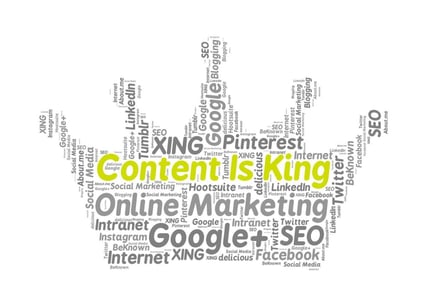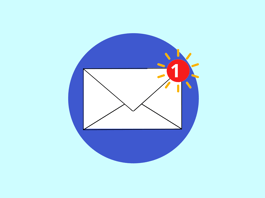Generating Leads with the CTA
If you have set-up strong marketing channels, your prospects may find you. However once they find you via your website, blog, or social media page (i.e. LinkedIn, Facebook, Twitter, etc.), how will you turn these prospects into real leads?

The Call-to-Action
Once a prospect reviews the valuable information you provide in your content, he/she will click on the call-to-action (CTA) you provide — an image, button, or message that encourages website visitors to take some sort of action.

The CTA takes your visitor to a landing page, which is a web page that is designed to capture lead information in exchange for an offer.
An offer is the content or something of value that's being "offered" on the landing page like an ebook, a course, or a template. The offer must have enough perceived value to a visitor to merit providing their personal information in exchange for access to it. A cooking site, for example, might offer a PDF of recipes entitled -- 7 Family Friendly Gluten-free Dinner Recipes.
The form on your landing page consists of a series of fields that collect information in exchange for the offer. Forms are typically hosted on landing pages, although they can technically be embedded anywhere on your site. Once your visitor fills this out — voila! — you have a new lead! (That is, as long as you’re following lead-capture form best practices.)
Lead Generation Marketing
Once you put all these elements together, you can use your various promotional channels to drive traffic to your landing page to start generating leads.
But what channels should you use to promote your landing page? Let’s talk about the front-end of lead generation — lead gen marketing.
Content

Content is a great way to guide users to a landing page. Typically, you create content to give visitors useful, free information. You can include CTAs anywhere in your content — inline, bottom-of-post, in the hero, or even on the side panel. The more delighted a visitor is with your content, the more likely they are to click your call-to-action and move onto your landing page. A real estate company, for example, can provide an informative article like -- A Guide to locating the Best Residential Investments in New York City.
 Email is another great platform to reach the people who already know your brand and your niche. It’s much easier to ask them to take an action since they’ve previously subscribed to your list. Emails tend to be a bit cluttered, so use CTAs that have a compelling copy. In other words, offer solutions to your prospects pain points. Patients get frustrated and angry when their doctor fails to respond in real-time to their messages. Real-time responsiveness is important to patients. What protocol does your busy medical office have in place to address this issue?
Email is another great platform to reach the people who already know your brand and your niche. It’s much easier to ask them to take an action since they’ve previously subscribed to your list. Emails tend to be a bit cluttered, so use CTAs that have a compelling copy. In other words, offer solutions to your prospects pain points. Patients get frustrated and angry when their doctor fails to respond in real-time to their messages. Real-time responsiveness is important to patients. What protocol does your busy medical office have in place to address this issue?
Blog

The great thing about using your blog posts to promote an offer is that you can tailor the entire piece to the end goal. You can post an informational video - Ten Tips to Choosing the Right CRO for Your Clinical Trials. Under the video, you can place the CTA offering a text version of the video or a more detailed document on the same subject.
Social Media

Social media platforms make it easy to guide your followers to take action, from the swipe up option on Instagram stories to Facebook bio links to bitly URLs on Twitter. You can also promote your offerings on your social posts and include a call-to-action in your caption.
Why Not Just Buy Leads?
Marketers and salespeople alike want to fill their sales funnel — and they want to fill it quickly. Enter -- the temptation to buy leads.
Buying leads, as opposed to organically generating them, is much easier and takes far less time and effort, despite being more expensive. But, you might be paying for advertising anyway … so, why not just buy leads?

First, any leads you've purchased don't actually know you. Typically, they've "opted in" at some other site when signing up for something, and didn't actually opt in to receiving anything from your company.
The messages you send them are therefore unwanted messages, and sending unwanted messages is intrusive. (How would YOU like to receive a call from a random stranger in the middle of your lunch break at work?!)
If the prospect has never been to your website and indicated an interest in your landscaping company, then you’re interrupting them. Plain and simple. If they’ve never opted in to receive messages from you, then there’s a high chance they could flag your message as spam, which isn’t good for business. In short, it’s always better to generate leads organically rather than to purchase them.
When it comes to generating leads, remember -- do your research. Understand the needs of your target prospects. Write content that shows them you have solutions for them. Post this content on their preferred media channel. Offer them valuable resources for free using a call-to-action button. Then, follow-up and continue to provide value throughout their "buyer's journey."
While it's a lot easier to buy a lead sheet than generate leads on your own, your hard work will pay off with warm, receptive leads.
Your Articles Need SkimCatchables
Skim-Catchables are bloggers' - now- not-so- secret weapon to make readers' jobs easier because they can easily skim down a page and find the answer to what they are looking for. Engaging titles and subtitles, gorgeous infographics, and functions like TL; DR (Too long; didn’t’ read) not only help readers, but should be part of any writer's tool kit!
Topic #Marketing,#Digital Marketing,#Free Stuff,#Generating Leads,#"landing pages"
Leave us
a Comment!